
|
|||
|
Jeep FAQ How-To Articles Quick Reference Product Reviews My Buildup Random Home |
Changing your own oil seems like a simple enough task for many people, but this is more for the beginners out there. Lets face it, we didn't all start out by doing axle swaps, we started by changing oil. So why should you change your own oil? Easy, you know its done right, with a quality filter and oil. You really should not be going to one of those $15 quick lube places, you are just guaranteed to get cheapest filter they can possibly find, with the cheapest oil they can find, and washer fluid reservoir filled with a mixture of 90% water 10% washer fluid. You get what you pay for. Don't make the oil and filter decision harder than it needs to be. You can research oils for days, and be even more confused then when you started. Just buy a national brand oil, and national brand filter, change it on a regular basis, and you'll be fine. As far as I know all manufacturers are still recommending a 3000 mile oil change intervals, if you do nothing but highway driving some manufacturers are recommending 5000-6000 change intervals. Maintenance Intervals can be found here: FAQ: Maintenance Intervals: To find out how much oil you need, follow this link: FAQ: Fluid Capacities For those with Jeeps taking a Fram PH16 filter (most Jeeps), you can use a Fram PH8A filter instead if you wish. This gets you an extra half quart of oil in there. The PH16 is a 0.5 quart filter, while the PH8A is a 1 quart filter. Make sure if you use the tall filter (PH8A) to add an extra half quart of oil to your Jeep. Ok for many reasons I run full synthetic oil in my vehicles, along with a quality filter. It only costs me $4-5 extra (total) to run the synthetic oil rather than conventional oil, so its an easy choice for me. 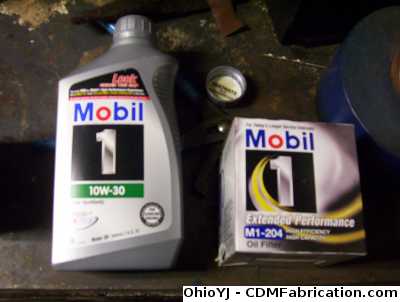
Time to actually get started. Get a large drain pan and place it under the oil pan. Now DO NOT do this after the motor has been run for any length of time, as the oil will be burning hot. Loosen the drain plug, it should come pretty easily with a wrench. If you've been using quick lube places you're likely to find that they have way over tightened your drain plug, so you may need a larger ratchet to break it free. Be ready to quickly move the pan as necessary, as odds are high it won't be in the right place the first time. 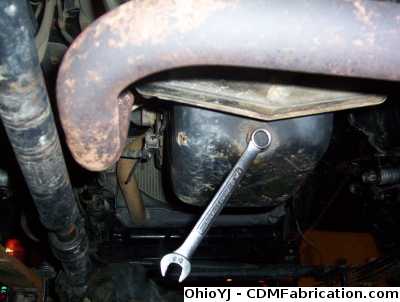
Let it drain until you are just getting a few drips from the pan every now and then. Wipe the pan clean on the outside, and reinstall the drain plug. The drain plug is not a lug nut, don't go nuts on it. If you don't have a torque wrench, just use a wrench to tighten it. Torque specs for the drain plug can be found here: FAQ: Torque Specs To remove the filter you have many choices. From left to right here, oil filter pliers, strap wrench, and filter socket. The strap wrench is the most common, but many times it won't get off an over tighten oil filter. The filter socket is the same way, if the filter has been installed too tight, it won't get it. Personally I prefer the pliers, always have. 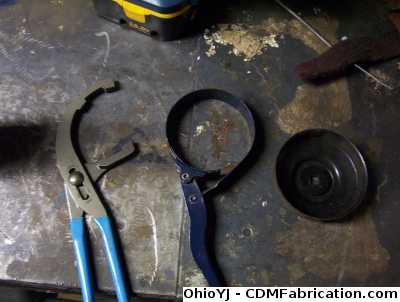
Now as I've mentioned, many times quick lube places over tighten the filters, so don't worry if you dent, or damage the old filter getting it off. If its being really stubborn don't worry about crushing the filter some to get a better grip on it. 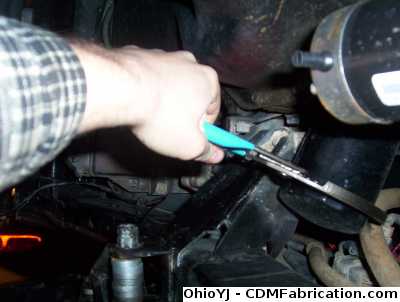
Once the filter is off, look at it for a moment. This is important, make sure the o-ring gasket is still on top of the old filter. If its not, its still on the block, pull it off. If you end up with two gaskets on there, you'll have leaks. You'd be amazed how many people make that mistake. Next take your oil filter, and dip your finger in some clean oil, and smear it around on the new o-ring on the new filter. Next, take your new filter and pour some oil in, if the oil filter was perfectly vertical I'd say fill it completely full (You'll have to pour some in, let it soak through, then pour in some more). This will help you get oil pressure sooner when you first start the motor. Since the Jeep oil filters are at an angle, don't fill it more than about half way full otherwise it may spill out when you go to screw the new filter on. Put the new filter on and tighten it by hand till it gets seated. Then wipe it off with a rag so you can easily gripe it, and use both hands to tighten it some more. Now go back to your filter wrench and turn it 3/4 of a turn more. If you are using the filter pliers like me, be careful not to squeeze the new filter too hard, you don't want to dent it. 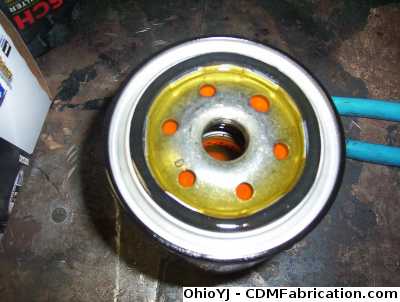
Once the filter is tight, wipe off any oil that may have spilled on the block while removing the filter. Now go up top and fill the motor with the proper amount of oil. Once you've poured in the proper amount of oil, give it a few seconds for all the oil to drain back into the pan. Now start the Jeep up, just let it idle for 30 seconds, looking underneath it for leaks, if you see any leaks shut it off and find out where the leak is coming from. If there are no leaks, shut it off and check the dip stick to make sure you really do have the proper amount of oil in your Jeep. You should be good to go at this point. Its a good idea to go ahead and give the Jeep a brief inspection, check the belts, hoses, fluids, tire pressure, air filter condition, etc. Normally you should grease all grease fittings too at this time.
© Copyright 2006 - 2024 Mike Lee
|
|
|